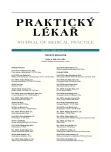Updated guidelines for the management of atrial fibrillation and its systemic arterial thromboembolic complications
Authors:
P. Gavornik; Ľ. Gašpar; A. Dukát
Authors‘ workplace:
II. interná klinika LFUK-UNB, Bratislava, Slovenská republika, Prednosta: doc. MUDr. Ľudovít Gašpar, CSc., Prvé angiologické pracovisko (PAP), Vedúci lekár: doc. MUDr. Peter Gavorník, CSc., PhD., mim. prof.
Published in:
Prakt. Lék. 2011; 91(11): 662-664
Category:
Of different specialties
Overview
According to the recent knowledge and new methods regarding management of atrial fibrillation, the European Society of Cardiology (ESC) has published (2010) its new Guidelines for the management of atrial fibrillation. The goal of this paper from the Angiologists’ Section of the Slovak Medical Chamber is to present the updated guidelines to the readers in a more transparent and concise form.
Much of the morbidity and mortality associated with atrial fibrillation is due to organovascular arterial thromboembolic complications, mainly involving the cerebrovascular arterial system and resulting in ischemic stroke. The limitation of current anticoagulation with vitamin K antagonists suggests the need for antithrombotic strategies or new antithrombotic drugs with more favourable safety profiles that do not require coagulation monitoring or dose adjustment.
Dabigatran confirms better effect on stroke incidence and systemic arterial thromboembolization and lower risk of major bleeding in comparison with warfarin. Dronedarone is the first antiarrhythmic drug, which has reduced cardiovascular hospitalisation and mortality.
Key words:
atrial fibrillation, arterial thromboembolization, cerebrovascular diseases, thromboprophylaxis, cardioversion, antiarrhythmic therapy.
Sources
1. Gavorník, P. Etiopatogenéza neurovaskulárnych ischemických chorôb (syndrómov). Neurológia 2010, 5(2), s. 61-68.
2. Camm, A.J., Kirchhof, P., Lip, G.Y.H. et al. Guidelines for the management of atrial fibrillation. The Task Force for the Management of Atrial Fibrillation of the European Society of Cardiology (ESC). Developed with special contribution of the European Heart Rhythm Association (EHRA) and Endorsed by The European Association for Cardio-Thoracic Surgery (EACTS). Eur. Heart. J. 2010, 31(19), p. 2369-2429.
3. Fuster, V., Ryden, L.E., Cannom, D.S. et al. Task Force on Practice Guidelines, American College of Cardiology/American Heart Association; Committee for Practice Guidelines, European Society of Cardiology; European Heart Rhythm Association; Heart Rhythm Society. ACC/ AHA/ ESC 2006 guidelins for the management of patients with atrial fibrillation – executive summary: a report of the American College of Cardiology/American Heart Association Task Force on practice guidelines and the European Society of Cardiology Committee for Practice Guidelines (Writing Committee to Revise the 2001 Guidelines for the Management of Patients with Atrial Fibrillation). Eur. Heart. J. 2006, 27(16), p. 1979-2030.
4. Gavorník, P. Flebotromboprofylaxia v klinickej praxi. Cardiology 2010, 19(2), p. 98-102.
5. Gavorník, P. Artériotromboprofylaxia v klinickej praxi. Cardiology 2010, 19(4), s. 293-299.
6. Lip, G.Y., Nieuwlaat, R., Pistetr, R. et al. Refining clinical risk stratification for predicting stroke and thromboembolism in atrial fibrillation using a novel risk-factor-based approach: the Euro Heart Survey on atrial fibrillation. Chest 2010, 137(2), p. 263-272.
7. Lip, G.Y., Halperin, J.L. Improving stroke risk stratification in atrial fibrillation. Am. J. Med. 2010, 123(6): p. 484-488.
8. Connolly, S.J., Ezekowitz, M.D., Yusuf, S. et al. Dabigatran versus warfarin in patients with atrial fibrillation. N. Engl. J. Med. 2009, 361(12), p. 1139-1151.
9. Pisters, R., Lane, D.A., Nieuwlaat, R. et al. A novel user-friendly score (HAS-BLED) to assess one-year risk of major bleeding in atrial fibrillation patients: The Euro Heart Survey. Chest 2010, 138(5), p. 1093-1100.
10. Lip, G.Y. Implications of the CHA(2)DS(2)-VASc and HAS-BLED Scores for thromboprophylaxis in atrial fibrillation. Am. J. Med. 2011, 124(2), p. 111-114.
11. Schmidt, C., Kisselbach, J., Schweizer, P.A. et al. The pathology and treatment of cardiac arrhythmias: focus on atrial fibrillation. Vasc. Health Risk. Manag. 2011, 7(3), p. 193-202.
12. Hohnloser, S.H., Crijns, H.J., van Eickels, M. et al. For the ATHENA Investigators. Effect of dronedarone on cardiovascular events in atrial fibrillation. N. Engl. J. Med. 2009, 360(7), p. 668-678.
13. Duray, G.Z., Schmitt, J., Hohnloser, S.H. Dronedarone therapy in atrial fibrillation: A summary of recent controlled trials. J. Cardiovasc. Pharmacol. Ther. 2010, 15 (4 Suppl), 19S-30S.
14. Penugonda, N., Mohmand-Borkowski, A., Burke, J.F. Dronedarone for atrial fibrillation: How does in compare with amiodarone? Cleve Clin. J. Med. 2011, 78(3), p. 179-185.
15. Page, R.L., Connoly, S.J., Crijns, H.J. et al. Rhythm- and rate-controlling effects of dronedarone in patients with atrial fibrillation (from ATHENA trial). Am. J. Cardiol. 2011, 107(7), p. 1019-1022.
16. Piccini, J.P., Hasselblad, V., Peterson, E.D. et al. Comparative efficacy of dronedarone and amiodarone for the maintenance of sinus rhythm in patients with atrial fibrillation. J. Am. Coll. Cardiol. 2009, 54(12), p. 1089-1095.
17. Le Heuzey, J.Y., De Ferrari, G.M., Radzik, D. et al. A short-term, randomized, double blind, parallel-group study to evaluate the efficacy and safety of dronedarone versus amiodarone in patients with persistent atrial fibrillation: The DIONYSOS study. J. Cardiovasc. Electrophysiol. 2010, 21(6), p. 597-605.
18. Hlivák, P., Hatala, R. Manažment antitrombotickej liečby pri katétrovej ablácii arytmií. Kardiol. prax. 2010, 8(3), s. 131-141.
19. Cappato, R., Calkins, H., Chen, S.A. et al. Update worldwide survey on the methods, efficacy, and safety of catheter ablation for human atrial fibrillation. Circ. Arrhythm. Electrophysiol. 2010, 3, p. 32-38.
20. Gavorník, P., Dukát, A., Gašpar, Ľ. a kol. Prevencia a liečba orgánovocievnych artériových ischemických chorôb. Prakt. Lék. 2010, 90(12), s. 708-714.
Labels
General practitioner for children and adolescents General practitioner for adultsArticle was published in
General Practitioner

2011 Issue 11
Most read in this issue
- Faecal calprotectin
- Probiotics from the view of the general practitioner – clinical indications for the use of probiotics, results a questionnaire study among general practitioners
- Pulmonary embolism and its diagnostic problems
- Actinic keratosis: the facts about biological behaviour and clinico-pathological aspects of the disease from the view of pathologist
